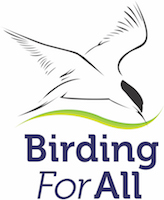GOB 39 – What’s that big red bird again?
Having a large international birding website, its hardly surprising that I get asked for ID help from around the globe. While the right response probably ought to be: ‘how the hell would I know’, what I usually ask is: ‘where are you?’
The thing is, that if you have a page for every country and state, and people mostly use ‘their’ page, they somehow assume that you live in the same area as they do.
I don’t always need to establish the location, for example, when someone emails: ‘…there’s a big pink and blue bird in my garden, I’ve never seen one before. What is it?’ I say ‘…is it bigger than a blackbird with a streaky head?’ The thing is I’ve already figured out that they will affirm as, believe it or not, this is the classic description of a Jay if you don’t bird. Yeah, it is sort of pink I guess but the tiny blue wing flash looms very large in a non-birder’s eyes. Its one of those questions that mark out an English birder from the rest of the herd.
However, more often the question will be… ‘There is a big green bird in my yard… what is it?’
This is where I do need clarification, asking: ‘Where are you?’ I may have to add a rejoinder depending on their response. I’ll say: ‘Yes, but Victoria where?’
I already know that there is such a town in Malta, another in the Seychelles and one in Newfoundland…. At this point I learn there is one in Texas. This means I can jump to the conclusion that they have a Green Jay at their feeders – the lucky birders!
Lest I become blasé I remind myself of one such exchange about a bird in a municipal park in the UK, which after much quizzing of the enquirer I still had to conclude that it was a Blue Magpie; it should have been gracing a tree in Sri Lanka not a bush in a Midlands playground.
Apart from such escapees and I have also accumulated a file full of obscure photos. They are usually rather blurred parting shots of a bird’s backside, with the rest of the critter hidden behind a branch. I can usually combine experience, a pretty comprehensive field guide collection and my acumen as a devotee of the Times cryptic crossword to get a handle on the avian conundrum. Sometimes my confidence is later boosted by feedback. It turns out that Jane Doe of Middletown, Montana asked her cousin, whose workmate chairs the local Audubon club and he dropped by and confirmed my ID.
You can usually tell a birder from a gentile… er um grockle… errrr gadjee? What is the term for a non-birder – seeing the all the terms I’ve come across for people who are not part of the exclusive group seem to start with a ‘G’ maybe we should call them ‘girders’?
The way a question is phrased is the great divide.
I don’t mean that you get asked to help tell one species from another by the length of the primaries or the colour of fringes on the coverts. However, no birder would simply ask what a big brown bird is. Nor would they ask about one that is about the size of a crow but with a bright red chest as I was recently asked. On a bit of prodding I found out that the bird was rather smaller than first said and that it had a nice grey backside that the enquirer could see well as it plucked the berries from a hawthorn. Anyway, Fieldfares always seem to set out to fool girders. A birder is more likely to hazard a guess at the species and offer some help with elimination… They will say: ‘I know it’s not a Sparrowhawk as they regularly sit on our fence plucking chaffinches, so I wondered how I can be sure it’s a Goshawk?’
Of course we birders can get size wrong, or even describe colour in an odd way, but we are tuned-in to salient features… we cannot help but look for eye stripes and wing bars, flight modes and how a bird walks across the lawn.
I was watching ‘Pointless’ on TV the other day and wasn’t shocked to see a Cuckoo identified as a Song Thrush, but I was taken aback by someone not recognising a Puffin! After all, they are everyday icons that are part of our cultural landscape regardless of our avian leanings. It’s not about familiarity necessarily. With the birds that share our gardens, most people would recognise a Blackbird and a Blue Tit, which are everyday visitors, but many of the uninitiated would probably struggle with a great tit or greenfinch when they should be equally familiar.
Some birds are ghosts in the cultural machine… Robins grace our Christmas cards, Swallows do a summer make, and Grey Herons and Mute Swans have forced themselves into our collective consciousness by virtue of their size and even distribution. However, ‘Girders’ will probably also recognise ‘bluebirds’ and ‘roadrunners’ thanks to American animators. What is more, most non-birders often lump whole families into one general species such as ‘seagulls’, even the term is a cultural marker drawing a line in the sand between birders and girders.
Back at the computer face, when regaled with requests, it becomes clear that we birders seem to incidentally identify much of what we see by what we call, risking giggles from American schoolboys, JIZZ.
The overall shape, size and general presentation of a bird in everyday pursuits allows us, once we put our birding eyes on, to automatically eliminate 99.99% of species without any conscious effort. We narrow the field further with a second glance, still JIZZ fuelled, as the bird bounces or loops away, soars on unbending wings, or rises skyward then descends in song. Long before we start to look for eye-stripes and wing bars, let alone primary projections, or the fringes of the outer coverts, we recognise it as a thrush or corvid, hirundine or warbler.
Only then do we plumb the bottom of our brains, or flip the pages of a field-guide, to narrow down which particular member of the finch family, or tit troop, we are watching. It may not be natural, but it certainly does become second nature, long before we even buy a baseball cap in a reserve centre, or smother our scopes with stickers.
Many years ago Hawkeye and I were drifting along a canal into the open waters of Caroni Swamp on Trinidad as dusk fell. We drifted into the mangroves as Snowy Egrets and Tri-coloured Herons started to bedeck the bushes, before they were joined in the roost by truly outstanding and iconic birds, hundreds of Scarlet Ibis.
As we marvelled at the Christmas decorations draping every tree a non-birder in the back of the boat whined, and not for the first time that evening… ‘now… what’s that big red bird again?’
Hear the Podcast





